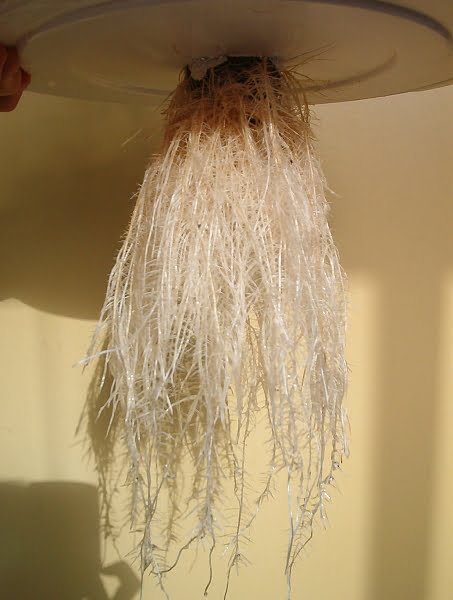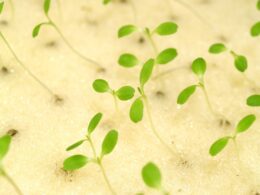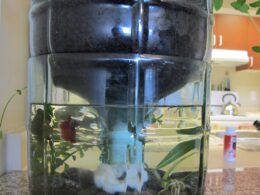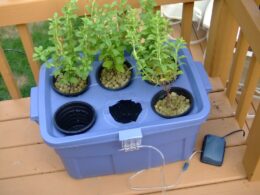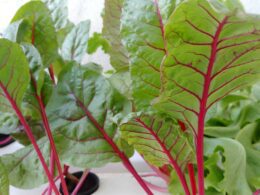Do you want to know which plants grow faster: hydroponically or in soil? This is a question many gardeners and farmers have been asking themselves for years.
While both methods of plant growth have their advantages and disadvantages, the answer to this question ultimately depends on the type of plant you are trying to grow and the environment in which you are growing it.
Hydroponic plant growth involves growing plants in a nutrient-rich solution without the use of soil. This method of plant growth has become increasingly popular in recent years due to its many benefits, including faster growth rates and higher yields.
However, soil-based plant growth has been used for thousands of years and is still the most common method of plant growth today. While it may not be as efficient as hydroponic plant growth, soil-based plant growth has its own set of advantages that make it a viable option for many gardeners and farmers.
Overview of Hydroponic and Soil-Based Plant Growth Techniques
The methods for cultivating plants through nutrient-rich solutions or traditional earth-based mediums are explored in the following section. Hydroponic and aquaponic techniques involve growing plants in water-based solutions, with the difference being that aquaponics involves the use of fish waste to provide nutrients for the plants.
On the other hand, soil-based techniques rely on the natural nutrients found in soil. One of the advantages of hydroponic and aquaponic techniques is that they allow for more control over the plant’s environment. Nutrient levels can be easily adjusted, and pests and diseases are less likely to affect the plants.
However, soil-based techniques can be more forgiving to mistakes in nutrient management and pH levels. Soil pH levels can greatly impact plant growth, as some plants prefer acidic soil while others prefer alkaline soil. In terms of growth rate, it is difficult to determine whether hydroponic or soil-based techniques produce faster growth.
This is because growth rate is dependent on many factors, such as plant species, nutrient management, and environmental factors. However, some studies have shown that hydroponic techniques can produce faster growth rates for certain plants. Ultimately, the choice between hydroponic and soil-based techniques depends on the specific needs and preferences of the grower.
Advantages and Disadvantages of Hydroponic Plant Growth
Using a hydroponic system has its pros and cons. One of the benefits is that plants grow faster due to the controlled environment and the ability to provide nutrients directly to the roots. This means that you can have multiple harvests in a year compared to soil-based farming. Additionally, hydroponic systems use less water than soil-based systems, making them more sustainable and eco-friendly.
However, there are also drawbacks. One of the main concerns is the cost of setting up and maintaining a hydroponic system. The equipment and nutrients required can be expensive, and if not maintained properly, can lead to plant diseases and failure. In addition, hydroponic systems require a consistent energy source to maintain the controlled environment, which can add to the cost.
Another drawback is the limited diversity in crops that can be grown hydroponically compared to soil-based farming. While leafy greens and herbs thrive in hydroponic systems, crops such as root vegetables and fruit trees may not be as successful. This limits the variety of produce that can be grown through hydroponic farming.
Benefits of Hydroponic Farming:
- Faster plant growth and multiple harvests in a year
- Uses less water than soil-based farming
- Controlled environment for optimal plant growth
Drawbacks of Hydroponic Farming:
- Expensive setup and maintenance costs
- Requires a consistent energy source
- Limited diversity in crops that can be grown
Advantages and Disadvantages of Soil-Based Plant Growth
If you prefer a more traditional growing method, soil-based plant growth might be right up your alley. With nutrient-rich soil, you can ensure your plants are getting all the necessary elements for healthy growth. Soil-based growth typically requires less space and water than hydroponic methods.
Plus, soil-based growth has its disadvantages. It can be more susceptible to pests and diseases, and the soil can become depleted over time, requiring additional nutrients or even replacement. It also takes longer for plants to mature in soil-based systems compared to hydroponics.
Overall, soil-based plant growth has its pros and cons, and it ultimately depends on the specific needs and preferences of the grower.
Nutrient-rich soil
You’ll be amazed at how much more nourished your plants will be when you use soil that’s rich in nutrients. Nutrient-rich soil is essential for providing your plants with all the necessary minerals and vitamins they need to grow strong and healthy.
Here are a few reasons why nutrient-rich soil is so important:
-
Increased Yield: When your plants have access to the right nutrients, they produce more fruit, vegetables, or flowers. This means you get a higher yield from your garden, which can save you money and provide you with fresh, healthy produce.
-
Disease Resistance: Plants that are grown in nutrient-rich soil are better equipped to fight off pests and diseases. This is because they have a stronger immune system, which is essential for healthy growth.
-
Environmental Benefits: Using nutrient-rich soil helps to reduce the need for chemical fertilizers, which can have a negative impact on the environment. By using composting benefits and soil amendments, you can create a sustainable garden that benefits both your plants and the planet.
Incorporating nutrient-rich soil into your gardening routine is a simple and effective way to ensure that your plants are healthy and productive. By following composting benefits and soil amendments, you can create a garden that not only looks beautiful but also provides you with fresh, healthy produce while minimizing your environmental impact.
Traditional growing method
The traditional way of gardening has been practiced for centuries and has a charm and simplicity that can’t be replicated. It involves planting seeds in nutrient-rich soil and allowing them to grow using the natural sunlight. With this method, the plants receive all the necessary nutrients and minerals from the soil.
However, it can be difficult to maintain the right conditions for the plants to thrive, especially in regions with harsh climates. When compared with aeroponics, traditional farming techniques may seem outdated. But it’s important to remember that different regions have different methods of farming that have been passed down for generations.
Traditional farming techniques have been refined over time to suit the specific needs of each region. And while hydroponics and aeroponics may have their benefits, they cannot completely replace the charm and simplicity of traditional farming.
Space and water requirements
To maximize your gardening space and conserve water, it’s important to consider the space and water requirements of your plants. With traditional soil-based growing methods, plants require a lot of space to spread their roots and access nutrients. This can limit the number of plants you can grow in a small area.
Additionally, traditional watering methods can be wasteful, with water often evaporating or running off into the ground. However, with vertical farming and hydroponic systems, you can grow plants in a much smaller space and conserve water through drip irrigation.
Vertical farming allows you to stack plants on top of each other, making use of vertical space that might otherwise go unused. Hydroponic systems, which use nutrient-rich water instead of soil, can also be designed to use drip irrigation, which delivers water directly to the roots of the plants, reducing waste.
By considering the space and water requirements of your plants, you can optimize your growing setup to produce a bountiful harvest while minimizing waste.
Will Plants Grow Faster in Hydroponics Compared to Soil?
Plants’ growth in hydroponics can indeed be faster compared to soil. Hydroponics provides plants with direct access to nutrients and water, enabling them to grow more efficiently. In this soilless system, plants do not need to allocate energy to search for nutrients, resulting in faster growth rates. Additionally, hydroponics allows for optimal control over environmental factors, such as pH and temperature, further enhancing plant growth.
Scientific Comparison of Plant Growth in Hydroponic and Soil-Based Environments
When it comes to plant growth, you’re probably curious about which environment yields better results: hydroponic or soil-based. Let’s take a closer look at nutrient uptake, root development, and growth rate. By examining these key points, you’ll gain a scientific comparison of how plants grow in each environment.
Adjust the paragraph structure in the input to logically group complete sentences on their own lines, with a double new line after. Use contractions.
Nutrient uptake
You’ll notice a significant difference in nutrient uptake between plants grown using hydroponic methods and those grown in soil. In hydroponic systems, plants are provided with a carefully balanced nutrient solution that contains all the necessary minerals and elements for growth. This allows plants to take up nutrients more efficiently, resulting in faster and healthier growth.
On the other hand, in soil-based environments, plants rely on the nutrients present in the soil, which can vary greatly in quality and quantity. Moreover, the pH levels in soil can affect nutrient availability, making it harder for plants to absorb the nutrients they need. In hydroponic systems, pH levels can be adjusted to optimize nutrient uptake, ensuring that plants get the right balance of nutrients at all times.
This level of control is simply not possible in soil-based environments, where pH levels are largely determined by the soil itself. Furthermore, hydroponic systems recycle and reuse the nutrient solution, minimizing waste and ensuring that plants have a constant supply of nutrients.
All in all, when it comes to nutrient uptake, hydroponic systems have a clear advantage over soil-based environments.
Root development
Your plants’ roots will thrive in a hydroponic system, as they’re able to spread out and absorb nutrients from the nutrient-rich solution that surrounds them. This is because hydroponic systems allow for root pruning. You can control the size of your plant’s roots by trimming them back to encourage new growth.
In addition, hydroponic systems use aeration techniques that provide oxygen to the roots, which is essential for healthy growth. This helps to prevent root rot and other fungal diseases that can occur in soil-based systems.
When it comes to root development, pH levels also play an important role. In a hydroponic system, you have more control over the pH levels. You can adjust them to suit the needs of your plants. For example, if your plants prefer a more acidic environment, you can lower the pH level to promote root growth. Conversely, if your plants prefer a more alkaline environment, you can raise the pH level.
By monitoring and adjusting the pH levels, you can ensure that your plants’ roots are able to absorb the nutrients they need to grow strong and healthy.
Growth rate
You can expect your plants to experience a rapid increase in size and development in a hydroponic system, thanks to the optimized nutrient and oxygen availability. In fact, plants grown hydroponically can grow up to 50% faster than those grown in soil! This is because the nutrients are delivered directly to the roots in a hydroponic system, allowing the plant to focus its energy on growth rather than searching for nutrients in the soil. Additionally, the oxygen-rich environment in hydroponic systems promotes healthy root development, which in turn leads to faster growth.
When comparing growth rates between hydroponic and soil-based methods, it’s important to consider the various factors that can affect plant growth. In hydroponic systems, growth rate can be influenced by factors such as pH levels, nutrient concentrations, and lighting. Soil-based methods, on the other hand, can be affected by factors such as soil quality, drainage, and nutrient availability. By carefully controlling these factors in a hydroponic system, you can ensure that your plants are able to grow at their maximum potential, resulting in faster growth and healthier plants overall.
Determining the Optimal Growing Method for Different Types of Crops and Environments
When it comes to growing leafy greens, fruiting plants, and other crops, the optimal growing method can vary depending on the specific type of crop and the environment in which it is being grown. If you’re growing indoors, for example, you may need to use different techniques than if you were growing outdoors.
By understanding the best growing methods for different crops and environments, you can optimize your yields and ensure that your plants thrive.
Leafy greens
Leafy greens thrive in a variety of growing environments, each with their own unique advantages and challenges. When it comes to hydroponics versus soil, leafy greens tend to grow faster hydroponically. This is because nutrient solutions can be precisely controlled in hydroponics, providing the plants with optimal nutrition. Additionally, lighting requirements can also be more easily met in hydroponics, as artificial lighting can be adjusted to provide the correct intensity and duration.
However, it’s important to note that soil-grown leafy greens can still produce high yields and be just as nutritious as hydroponically grown ones. In fact, some people even prefer the taste of soil-grown greens. The key is to understand the specific needs of the crop and environment, and choose the growing method that best suits those needs.
With proper care and attention, both hydroponic and soil-grown leafy greens can thrive and provide a healthy addition to your diet.
Fruiting plants
Fruiting plants present a new set of considerations for cultivation, as their unique nutritional and lighting needs must be carefully balanced to ensure optimal growth and yield.
When it comes to comparing hydroponic and soil-based growth for fruiting plants, there are a few key factors to consider. One of the most important is fruit yield. Studies have shown that hydroponically grown fruiting plants can produce higher yields than those grown in soil. This is because hydroponic systems provide a more controlled environment with consistent access to water, nutrients, and oxygen.
Another important consideration is disease resistance. Fruiting plants are particularly susceptible to diseases that can affect the quality and quantity of the fruit produced. Hydroponic systems can help reduce the risk of disease by providing a sterile growing environment that is less prone to contamination. Soil-based systems, on the other hand, are more susceptible to disease because they can harbor pathogens that can infect the plants.
Overall, when it comes to growing fruiting plants, hydroponic systems offer several advantages over soil-based systems, including higher yields and better disease resistance.
Indoor vs. outdoor environments
If you want to experiment with different growing environments, you may want to consider the pros and cons of growing your plants indoors versus outdoors. While indoor environments may offer greater control over lighting and humidity, outdoor environments can provide natural sunlight and air circulation that can be difficult to replicate indoors.
Here are four factors to consider when deciding whether to grow your plants indoors or outdoors:
-
Indoor lighting: While indoor environments provide the opportunity to control the amount and duration of light your plants receive, it can also be costly to invest in and maintain artificial lighting systems.
-
Outdoor temperature: Depending on the climate you live in, outdoor temperatures can fluctuate dramatically, which can stress your plants and affect their growth.
-
Humidity control: Indoor environments allow for greater control over humidity levels, which can be important for some plants. However, it can also be difficult to maintain optimal humidity levels without investing in expensive equipment.
-
Pest management: Outdoor environments can expose your plants to a wider range of pests and diseases, which can be difficult to manage without the use of chemicals or natural pest control methods.
Ultimately, the decision to grow your plants indoors or outdoors will depend on your specific needs and resources. Consider these factors carefully before making your choice, and remember that both indoor and outdoor environments can be successful with the right planning and management.
Frequently Asked Questions
What are the startup costs associated with hydroponic and soil-based plant growth techniques?
Looking to start a plant growth business and unsure about the best method to use? Hydroponic and soil-based techniques both have their own unique startup costs, equipment requirements, and maintenance needs.
While hydroponics may require more upfront costs for specialized equipment and nutrient solutions, it can lead to a higher ROI due to its efficiency in water usage and faster growth rates. On the other hand, soil-based methods may be more affordable to start but may require more maintenance and a larger growing space.
Analyzing market trends can also play a role in deciding which method to use. Ultimately, the choice between hydroponic and soil-based methods depends on your specific goals and resources.
How do you maintain pH levels in a hydroponic system?
Maintaining pH levels in hydroponics is essential for the health and growth of your plants. The pH level can affect nutrient uptake and lead to deficiencies or toxicities.
To maintain the pH level in your hydroponic system, you need to use techniques and tools such as pH meters, pH adjusters, and buffering agents. It’s important to regularly monitor and adjust the pH level to keep it within the optimal range for your plants.
However, there are challenges to maintaining the pH level in hydroponics, such as fluctuations caused by plant uptake, evaporation, and nutrient solution changes. With the right techniques and tools, you can overcome these challenges and ensure that your plants thrive in a hydroponic system.
Are there any environmental concerns or drawbacks associated with hydroponic plant growth?
When it comes to hydroponic plant growth, there are some potential environmental concerns and drawbacks to consider. One of the primary issues is sustainability. Hydroponic systems require a lot of energy to operate, especially when it comes to lighting and heating the water.
Additionally, the production of hydroponic nutrients and equipment can have a significant environmental impact. However, there are also potential benefits to hydroponic systems, such as reduced water usage and the ability to grow crops in areas with poor soil quality.
Ultimately, the best approach is to weigh the potential benefits and drawbacks of hydroponic systems carefully and choose the most sustainable option for your needs.
Can hydroponic systems be used for large-scale commercial farming?
Looking to grow crops on a large scale? Vertical farming using hydroponic systems might just be the solution you need.
This innovative approach to farming can help you grow more crops per square foot and reduce your water usage by up to 90%.
And since it eliminates the need for soil, you won’t have to worry about soil-borne pests or diseases.
Best of all, hydroponic systems are extremely cost-effective and can help you save on labor, fertilizer, and energy costs.
So if you’re looking for a way to cut costs and increase yields, consider investing in a hydroponic system for your commercial farm.
How does the taste and nutrient content of plants grown hydroponically compare to those grown in soil?
When it comes to taste and nutrient content, there are some differences between plants grown hydroponically and those grown in soil. Hydroponically grown plants tend to have a more consistent taste, as they are grown in a controlled environment with carefully calibrated nutrient solutions.
However, some people argue that soil-grown plants have a richer flavor due to the complex mix of nutrients and microorganisms in the soil. In terms of nutrient profile, hydroponic plants can be just as nutritious as soil-grown plants, but the specific nutrient content may differ slightly depending on the nutrient solution used.
Ultimately, the choice between hydroponic and soil-grown plants comes down to personal preference and the specific needs of the individual.
Conclusion
So, which method of plant growth is better: hydroponic or soil-based? Well, it all depends on what you’re growing and where you’re growing it.
Hydroponics offer faster growth rates and the ability to control the environment, but they can be more expensive and require more maintenance.
Soil-based growth may be slower, but it’s often more affordable and offers a more natural growing environment.
Ultimately, the best way to determine the optimal growing method for your crops is through experimentation and observation. Try growing the same plants using both methods and see which yields better results. Consider the costs, maintenance, and environmental factors involved in each method.
With time and practice, you’ll find the best way to grow your plants and achieve the results you want.





